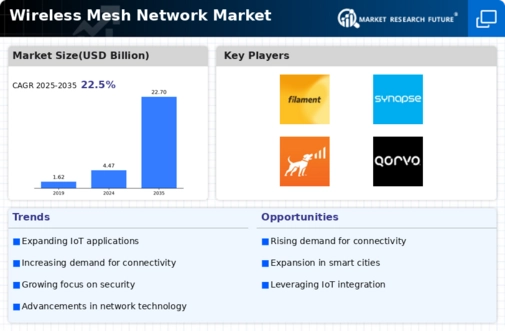Market Analysis
In-depth Analysis of Wireless Mesh Network Market Industry Landscape
The market dynamics of wireless mesh networks are influenced by various factors that shape the adoption, growth, and evolution of solutions designed to establish robust, self-organizing wireless communication infrastructures. Wireless mesh networks comprise interconnected nodes that communicate with each other to relay data, creating a flexible and scalable network topology. This market has experienced significant dynamics due to the increasing demand for reliable, resilient, and high-performance wireless connectivity across diverse environments, including smart cities, industrial IoT deployments, public safety, and enterprise applications.
One of the primary drivers of the market dynamics of wireless mesh networks is the growing need for ubiquitous and seamless connectivity in challenging environments, such as urban areas, industrial facilities, and outdoor spaces. As organizations and municipalities seek to bridge digital divides, support IoT deployments, and enable smart city applications, there has been a surge in the demand for wireless mesh network solutions that can deliver pervasive coverage, support mobility, and ensure connectivity in dynamic and harsh conditions. This trend is driven by the imperative to establish resilient and adaptable wireless communication infrastructures capable of meeting the diverse connectivity needs of modern applications and environments, thus influencing the market dynamics of wireless mesh networks.
Moreover, the proliferation of IoT devices, smart sensors, and connected infrastructure has played a pivotal role in shaping the market dynamics of wireless mesh networks. As the deployment of IoT and sensor networks becomes more pervasive in industrial, municipal, and enterprise settings, there is a corresponding need for wireless mesh network solutions that can support large-scale deployments, accommodate diverse devices, and facilitate efficient data transport. This has led to a surge in demand for wireless mesh network technologies that offer low-power operation, multi-hop communication, and support for IoT standards to enable comprehensive connectivity and data exchange within IoT ecosystems, thereby influencing the market dynamics of wireless mesh networks.
Additionally, the competitive landscape and technological advancements have significantly impacted the market dynamics of wireless mesh networks. The presence of established networking equipment providers offering wireless mesh network solutions, alongside the emergence of innovative technologies and specialized mesh networking companies, has intensified competition in the market. This has led to product differentiation, pricing strategies, and technological innovations aimed at capturing market share and addressing the evolving connectivity needs of smart city initiatives, industrial IoT deployments, and wireless infrastructure projects, thus influencing the market dynamics of wireless mesh networks.
Furthermore, the increasing focus on resilient and self-healing network architectures has propelled the demand for wireless mesh network solutions. As organizations and municipalities seek to establish fault-tolerant and adaptable wireless communication infrastructures, the need for wireless mesh network technologies that offer self-organizing capabilities, dynamic routing, and self-healing mechanisms has become paramount. Wireless mesh network solutions with enhanced capabilities to automatically reconfigure in the event of node failures, optimize network paths, and ensure continuous connectivity have gained prominence as organizations and municipalities strive to build robust and reliable wireless infrastructures, thereby influencing the market dynamics of wireless mesh networks.







Leave a Comment